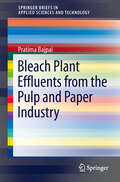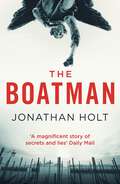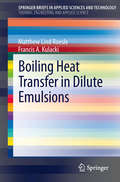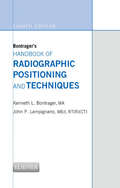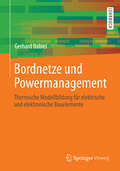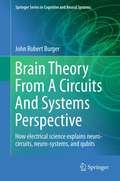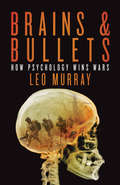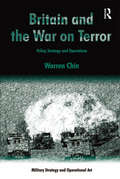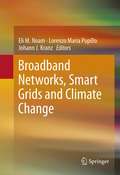- Table View
- List View
Bleach Plant Effluents from the Pulp and Paper Industry (SpringerBriefs in Applied Sciences and Technology)
by Pratima BajpaiThis book covers bleach plant effluents, that most polluting effluent from the pulp and paper industry. Disappearance of benthic invertebrates, a high incidence of fish diseases, and mutagenic effects on the aquatic fauna are some of the consequences of the disposal of bleach effluents into surface waters. This book describes environmental impact of bleach plant effluents, environmental regulations, and measures to reduce the pollution load by internal process modification and external treatment of bleach plant effluents.
Blechmodellierung mit CATIA V5: Effizientes Konstruieren von Blechbiegeteilen
by Thomas EiblBlechbiegeteile spielen im Maschinenbau aber auch im Alltag eine wichtige Rolle. Die Arbeitsumgebung Sheetmetal Design in CATIA V5 ist eine erweiterte Konstruktionsumgebung für das Konstruieren von Blechbiegeteilen und baut auf dem Part Design auf. Diese Schritt-für-Schritt-Anleitung zeigt sehr anschaulich das effiziente Konstruieren von einfachen bis zu komplexen Blechbiegeteilen und gerollten Blechteilen. Die Beschreibung der Basismethoden und der Konstruktionsmethodik sowie der Konstruktionsreihenfolge stehen im Vordergrund dieses Lehrbuches. Das Buch richtet sich an Studenten des Maschinenbaus an technischen Universitäten und Fachhochschulen sowie höheren technischen Lehranstalten und Fachschulen; ebenso an Ingenieure und Techniker sowie Teilnehmer von Weiterbildungskursen, die sich mit Fragestellungen der Blechmodellierung mit CATIA V5 beschäftigen.
Blind Identification and Separation of Complex-valued Signals
by Eric Moreau Tülay AdaliBlind identification consists of estimating a multi-dimensional system only through the use of its output, and source separation, the blind estimation of the inverse of the system. Estimation is generally carried out using different statistics of the output. The authors of this book consider the blind identification and source separation problem in the complex-domain, where the available statistical properties are richer and include non-circularity of the sources – underlying components. They define identifiability conditions and present state-of-the-art algorithms that are based on algebraic methods as well as iterative algorithms based on maximum likelihood theory. Contents 1. Mathematical Preliminaries. 2. Estimation by Joint Diagonalization. 3. Maximum Likelihood ICA. About the Authors Eric Moreau is Professor of Electrical Engineering at the University of Toulon, France. His research interests concern statistical signal processing, high order statistics and matrix/tensor decompositions with applications to data analysis, telecommunications and radar. Tülay Adali is Professor of Electrical Engineering and Director of the Machine Learning for Signal Processing Laboratory at the University of Maryland, Baltimore County, USA. Her research interests concern statistical and adaptive signal processing, with an emphasis on nonlinear and complex-valued signal processing, and applications in biomedical data analysis and communications. Blind identification consists of estimating a multidimensional system through the use of only its output. Source separation is concerned with the blind estimation of the inverse of the system. The estimation is generally performed by using different statistics of the outputs. The authors consider the blind estimation of a multiple input/multiple output (MIMO) system that mixes a number of underlying signals of interest called sources. They also consider the case of direct estimation of the inverse system for the purpose of source separation. They then describe the estimation theory associated with the identifiability conditions and dedicated algebraic algorithms. The algorithms depend critically on (statistical and/or time frequency) properties of complex sources that will be precisely described.
Blind Identification and Separation of Complex-valued Signals
by Eric Moreau Tülay AdaliBlind identification consists of estimating a multi-dimensional system only through the use of its output, and source separation, the blind estimation of the inverse of the system. Estimation is generally carried out using different statistics of the output. The authors of this book consider the blind identification and source separation problem in the complex-domain, where the available statistical properties are richer and include non-circularity of the sources – underlying components. They define identifiability conditions and present state-of-the-art algorithms that are based on algebraic methods as well as iterative algorithms based on maximum likelihood theory. Contents 1. Mathematical Preliminaries. 2. Estimation by Joint Diagonalization. 3. Maximum Likelihood ICA. About the Authors Eric Moreau is Professor of Electrical Engineering at the University of Toulon, France. His research interests concern statistical signal processing, high order statistics and matrix/tensor decompositions with applications to data analysis, telecommunications and radar. Tülay Adali is Professor of Electrical Engineering and Director of the Machine Learning for Signal Processing Laboratory at the University of Maryland, Baltimore County, USA. Her research interests concern statistical and adaptive signal processing, with an emphasis on nonlinear and complex-valued signal processing, and applications in biomedical data analysis and communications. Blind identification consists of estimating a multidimensional system through the use of only its output. Source separation is concerned with the blind estimation of the inverse of the system. The estimation is generally performed by using different statistics of the outputs. The authors consider the blind estimation of a multiple input/multiple output (MIMO) system that mixes a number of underlying signals of interest called sources. They also consider the case of direct estimation of the inverse system for the purpose of source separation. They then describe the estimation theory associated with the identifiability conditions and dedicated algebraic algorithms. The algorithms depend critically on (statistical and/or time frequency) properties of complex sources that will be precisely described.
Blind Source Separation: Theory and Applications
by Xianchuan Yu Dan Hu Jindong XuA systematic exploration of both classic and contemporary algorithms in blind source separation with practical case studies The book presents an overview of Blind Source Separation, a relatively new signal processing method. Due to the multidisciplinary nature of the subject, the book has been written so as to appeal to an audience from very different backgrounds. Basic mathematical skills (e.g. on matrix algebra and foundations of probability theory) are essential in order to understand the algorithms, although the book is written in an introductory, accessible style. This book offers a general overview of the basics of Blind Source Separation, important solutions and algorithms, and in-depth coverage of applications in image feature extraction, remote sensing image fusion, mixed-pixel decomposition of SAR images, image object recognition fMRI medical image processing, geochemical and geophysical data mining, mineral resources prediction and geoanomalies information recognition. Firstly, the background and theory basics of blind source separation are introduced, which provides the foundation for the following work. Matrix operation, foundations of probability theory and information theory basics are included here. There follows the fundamental mathematical model and fairly new but relatively established blind source separation algorithms, such as Independent Component Analysis (ICA) and its improved algorithms (Fast ICA, Maximum Likelihood ICA, Overcomplete ICA, Kernel ICA, Flexible ICA, Non-negative ICA, Constrained ICA, Optimised ICA). The last part of the book considers the very recent algorithms in BSS e.g. Sparse Component Analysis (SCA) and Non-negative Matrix Factorization (NMF). Meanwhile, in-depth cases are presented for each algorithm in order to help the reader understand the algorithm and its application field. A systematic exploration of both classic and contemporary algorithms in blind source separation with practical case studies Presents new improved algorithms aimed at different applications, such as image feature extraction, remote sensing image fusion, mixed-pixel decomposition of SAR images, image object recognition, and MRI medical image processing With applications in geochemical and geophysical data mining, mineral resources prediction and geoanomalies information recognition Written by an expert team with accredited innovations in blind source separation and its applications in natural science Accompanying website includes a software system providing codes for most of the algorithms mentioned in the book, enhancing the learning experience Essential reading for postgraduate students and researchers engaged in the area of signal processing, data mining, image processing and recognition, information, geosciences, life sciences.
Blind Source Separation: Theory and Applications
by Xianchuan Yu Dan Hu Jindong XuA systematic exploration of both classic and contemporary algorithms in blind source separation with practical case studies The book presents an overview of Blind Source Separation, a relatively new signal processing method. Due to the multidisciplinary nature of the subject, the book has been written so as to appeal to an audience from very different backgrounds. Basic mathematical skills (e.g. on matrix algebra and foundations of probability theory) are essential in order to understand the algorithms, although the book is written in an introductory, accessible style. This book offers a general overview of the basics of Blind Source Separation, important solutions and algorithms, and in-depth coverage of applications in image feature extraction, remote sensing image fusion, mixed-pixel decomposition of SAR images, image object recognition fMRI medical image processing, geochemical and geophysical data mining, mineral resources prediction and geoanomalies information recognition. Firstly, the background and theory basics of blind source separation are introduced, which provides the foundation for the following work. Matrix operation, foundations of probability theory and information theory basics are included here. There follows the fundamental mathematical model and fairly new but relatively established blind source separation algorithms, such as Independent Component Analysis (ICA) and its improved algorithms (Fast ICA, Maximum Likelihood ICA, Overcomplete ICA, Kernel ICA, Flexible ICA, Non-negative ICA, Constrained ICA, Optimised ICA). The last part of the book considers the very recent algorithms in BSS e.g. Sparse Component Analysis (SCA) and Non-negative Matrix Factorization (NMF). Meanwhile, in-depth cases are presented for each algorithm in order to help the reader understand the algorithm and its application field. A systematic exploration of both classic and contemporary algorithms in blind source separation with practical case studies Presents new improved algorithms aimed at different applications, such as image feature extraction, remote sensing image fusion, mixed-pixel decomposition of SAR images, image object recognition, and MRI medical image processing With applications in geochemical and geophysical data mining, mineral resources prediction and geoanomalies information recognition Written by an expert team with accredited innovations in blind source separation and its applications in natural science Accompanying website includes a software system providing codes for most of the algorithms mentioned in the book, enhancing the learning experience Essential reading for postgraduate students and researchers engaged in the area of signal processing, data mining, image processing and recognition, information, geosciences, life sciences.
Bluetooth Security Attacks: Comparative Analysis, Attacks, and Countermeasures (SpringerBriefs in Computer Science)
by Keijo Haataja Konstantin Hyppönen Sanna Pasanen Pekka ToivanenBluetooth technology has enjoyed tremendous success, and it's now employed in billions of devices for short-range wireless data and real-time audio or video transfer. In this book the authors provide an overview of Bluetooth security. They examine network vulnerabilities and provide a literature-review comparative analysis of recent security attacks. They analyze and explain related countermeasures, including one based on secure simple pairing, and they also propose a novel attack that works against all existing Bluetooth versions. They conclude with a discussion on future research directions. The book is appropriate for practitioners and researchers in information security, in particular those engaged in the design of networked and mobile devices.
The Boatman (The Carnivia Trilogy #1)
by Jonathan HoltA superb conspiracy thriller set in Venice, from a Sunday Times bestseller. ********They found the woman's body on the steps of a church, washed up by Venice's winter tides. A tattoo on her wrist matched graffiti in an abandoned hospital, not used since the Second World War. It's Captain Kat Tapo's first murder case, and she'll do anything to get to the truth. But as the hunt for the killer intensifies, she discovers secrets from Italy's dark wartime past that will put her in great danger... This is the first novel in a trilogy of stylish and intelligent thrillers set in Venice from Jonathan Holt who, under the name J.P. Delaney, is also the author of the Sunday Times bestselling psychological thrillers The Girl Before and The Perfect Wife. Previously published as The Abomination. ********Reviews for The Carnivia Trilogy: 'Genuinely thrilling... An illuminating portrait of a particular world' Literary Review. 'Tense and mind-bending' Daily Telegraph. 'Breathtaking... A truly haunting glimpse into a mysterious shadow world' New York Times. 'Impressive... Venice is a magnificent backdrop for a story of secrets and lies' Daily Mail. 'A cracking, upmarket thriller... A rare entertainment for the thinking deckchair reader'Saga Magazine. What readers are saying about The Carnivia Trilogy: 'Superb – an exciting tale involving people smuggling, the Catholic Church and US intelligence operatives... A compelling story which will appeal to readers who enjoy a mix of conspiracy theory and cover-up' Amazon Reader. 'An unravelling of several interconnected plot strands with action and twists that never stop, but at a deeper level Holt also engages with human rights and gender issues... This is a "can't put it down" novel' Amazon Reader. 'The detailed reconstruction of the setting in Venice is fabulous and is equalled both by characterisation and plot... Gripping and thrilling... and distressingly possible' Amazon Reader. 'Fabulously descriptive, intriguing, fast paced... A must-read for anyone who enjoys a good thriller that is well researched and excellently written' Amazon Reader. 'Fast paced, good characters and interesting mix of plot strands. Each book in the trilogy can be read as a stand alone, but reading all of them rounds off the story strands nicely' Amazon Reader.
Boiling Heat Transfer in Dilute Emulsions (SpringerBriefs in Applied Sciences and Technology)
by Matthew Lind Roesle Francis A. KulackiBoiling Heat Transfer in Dilute Emulsions synthesizes recent advances and established understanding on the subject of boiling in dilute emulsions. Experimental results from various sources are collected and analyzed, including contemporary experiments that correlate visualization with heat transfer data. Published models of boiling heat transfer in dilute emulsions, and their implementation, are described and assessed against experimental data.
Bontrager's Handbook of Radiographic Positioning and Techniques - E-BOOK
by Kenneth L. Bontrager John Lampignano"The various components contained in this handbook are presented in seamless combination and with a clarity becoming of a much larger work. The book is worthy of recommendation for all those interested in the strenghtening and honing of their core radiographic skills." Reviewed by: RAD Magazine, Barry K Denton, acting radiology services manager, Hywel Dda University Health Board, Wales Date: July 2014
Boolean Differential Equations (Synthesis Lectures on Digital Circuits & Systems)
by Bernd Steinbach Christian PosthoffThe Boolean Differential Calculus (BDC) is a very powerful theory that extends the structure of a Boolean Algebra significantly. Based on a small number of definitions, many theorems have been proven. The available operations have been efficiently implemented in several software packages. There is a very wide field of applications. While a Boolean Algebra is focused on values of logic functions, the BDC allows the evaluation of changes of function values. Such changes can be explored for pairs of function values as well as for whole subspaces. Due to the same basic data structures, the BDC can be applied to any task described by logic functions and equations together with the Boolean Algebra. The BDC can be widely used for the analysis, synthesis, and testing of digital circuits. Generally speaking, a Boolean differential equation (BDE) is an equation in which elements of the BDC appear. It includes variables, functions, and derivative operations of these functions. The solution of such a BDE is a set of Boolean functions. This is a significant extension of Boolean equations, which have sets of Boolean vectors as solutions. In the simplest BDE a derivative operation of the BDC on the left-hand side is equal to a logic function on the right-hand side. The solution of such a simple BDE means to execute an operation which is inverse to the given derivative. BDEs can be applied in the same fields as the BDC, however, their possibility to express sets of Boolean functions extends the application field significantly.
Bordnetze und Powermanagement: Thermische Modellbildung für elektrische und elektronische Bauelemente
by Gerhard BabielIn einem modernen Fahrzeug sind einige hundert Meter an Leitungen und Kabel verlegt. Einige tausend Kontaktstellen sind erforderlich, um die elektrischen Funktionen sicherzustellen. Mit jedem neuen elektronischen Produkt im KFZ wächst auch das Bordnetz an und erfordert immer höhere Anstrengungen zur Sicherheit und Zuverlässigkeit im Powermanagement. In diesem Buch findet sich neben den aus der Elektrotechnik und Werkstoffkunde bekannten Grundlagen auch ein spezielleres Kapitel (Kap. 5) zur wärmetechnischen Auslegung von Leitungen und Bordnetzkomponenten. Das theoretische Fundament dieses Kapitels wird durch einige Sätze aus der Differentialgeometrie und der Signaltheorie gelegt. Es wird aber auch Wert darauf gelegt, die Erkenntnisse für den Entwickler anzuwenden. Der Praxisbezug wird auch durch Übungs- bzw. Klausuraufgaben aus der Vorlesung „Bordnetze und Leistungshalbleiter“ untermauert.
Bounded Noises in Physics, Biology, and Engineering (Modeling and Simulation in Science, Engineering and Technology)
by Alberto D'OnofrioSince the parameters in dynamical systems of biological interest are inherently positive and bounded, bounded noises are a natural way to model the realistic stochastic fluctuations of a biological system that are caused by its interaction with the external world. Bounded Noises in Physics, Biology, and Engineering is the first contributed volume devoted to the modeling of bounded noises in theoretical and applied statistical mechanics, quantitative biology, and mathematical physics. It gives an overview of the current state-of-the-art and is intended to stimulate further research. The volume is organized in four parts. The first part presents the main kinds of bounded noises and their applications in theoretical physics. The theory of bounded stochastic processes is intimately linked to its applications to mathematical and statistical physics, and it would be difficult and unnatural to separate the theory from its physical applications. The second is devoted to framing bounded noises in the theory of random dynamical systems and random bifurcations, while the third is devoted to applications of bounded stochastic processes in biology, one of the major areas of potential applications of this subject. The final part concerns the application of bounded stochastic processes in mechanical and structural engineering, the area where the renewed interest for non-Gaussian bounded noises started. Pure mathematicians working on stochastic calculus will find here a rich source of problems that are challenging from the point of view of contemporary nonlinear analysis. Bounded Noises in Physics, Biology, and Engineering is intended for scientists working on stochastic processes with an interest in both fundamental issues and applications. It will appeal to a broad range of applied mathematicians, mathematical biologists, physicists, engineers, and researchers in other fields interested in complexity theory. It is accessible to anyone with a working knowledge of stochastic modeling, from advanced undergraduates to senior researchers.
Brain-Computer Interface Research: A State-of-the-Art Summary (SpringerBriefs in Electrical and Computer Engineering)
by Christoph Guger, Brendan Z. Allison and Günter EdlingerBrain-computer interfaces (BCIs) are rapidly developing into a mainstream, worldwide research endeavor. With so many new groups and projects, it can be difficult to identify the best ones. This book summarizes ten leading projects from around the world. About 60 submissions were received in 2011 for the highly competitive BCI Research Award, and an international jury selected the top ten. This Brief gives a concise but carefully illustrated and fully up-to-date description of each of these projects, together with an introduction and concluding chapter by the editors.
Brain Theory From A Circuits And Systems Perspective: How Electrical Science Explains Neuro-circuits, Neuro-systems, and Qubits (Springer Series in Cognitive and Neural Systems #6)
by John Robert BurgerThis book models an idealized neuron as being driven by basic electrical elements, the goal being to systematically characterize the logical properties of neural pulses. In order to constitute a system, neurons as pulsating devices may be represented using novel circuit elements as delineated in this book. A plausible brain system is implied by the delineated elements and logically follows from known and likely properties of a neuron. New to electrical science are novel pulse-related circuit elements involving recursive neurons. A recursive neuron, when properly excited, produces a self-sustaining pulse train that when sampled, provides a true output with a specified probability, and a false output with complementary probability. Because of its similarity to the qubits of quantum mechanics, the recursive pulsating neuron is termed a simulated qubit. Recursive neurons easily function as controlled toggle devices and so are capable of massively parallel calculations, this being a new dimension in brain functioning as described in this book. Simulated qubits and their possibilities are compared to the qubits of quantum physics. Included in the book are suggested neural circuits for associative memory search via a randomized process of cue selection, and neural circuits for priority calculations. These serve to select returns from long term memory, which in turn determines one's next conscious thought or action based on past memorized experiences. The book reports on proposals involving electron tunneling between synapses, and quantum computations within neurons. Although not a textbook, there are easy exercises at the ends of chapters, and in the appendix there are twelve simulation experiments concerning neurons.
Brains & Bullets: How psychology wins wars
by Leo MurrayThis book is the story of how Western armies forgot how to fight real people. It is not about generals and strategies; it is focused on small groups of men in desperate situations and how they use their brains and their bullets to make the enemy surrender.' The closer people get to war the less they like it. The human brain is hard-wired with a primal, almost imperceptible aversion to killing and an intense aversion to being killed. In order to win wars, vast effort and uncountable sums have been expended to try and quash these reactions in our soldiers. For years, this research focused on two questions: 'Who fights?' and 'How can we make more people fight?' In Brains & Bullets, military psychologist Leo Murray argues that, given the right conditions, everybody fights. Change those conditions, however, and almost everybody will stop fighting. If we really want to win wars, the question we ought to be asking is: 'How do we make the enemy stop fighting?' Interweaving intense first-hand accounts of combat with the hard science of tactical psychology, this extensively researched study offers a fascinating insight into what war does to the human mind. Most crucially, it also suggests a new way to approach military conflict - one which comes too late to change the outcome of the war in Afghanistan, but which may well have a profound effect on the future of modern warfare.
Breeding strategies for sustainable forage and turf grass improvement
by Susanne Barth and Dan MilbourneFrom the 4th – 8th of September 2011, the Eucarpia Fodder Crops and Amenity Grasses Section, held its 29th Meeting in the surroundings of Dublin Castle in Ireland. The theme of the meeting was ‘Breeding strategies for sustainable forage and turf grass improvement’. Grasslands cover a significant proportion of the land mass of the world, and play a pivotal role in global food production. At the same time we are faced with several challenges that affect the way in which we think about this valuable set of resources. The population of the world is expected to exceed 9 billion by 2050, and increase of about one third relative to today’s levels. This population increase will be focused in urban areas, and in what are currently viewed as “developing” countries, meaning that the buying power of this increased population will be greater – shifting the balance of demand from staple crops to high value items such as meat and dairy products. Overall that the world will have to approximately double agricultural output across all categories of food to meet the demands of this larger, urbanised population. This is occurring against a backdrop of equally large challenges in terms of global climate change. Agriculture is already a significant contributor to e.g. greenhouse gas emissions, deforestation and soil erosion. The situation is made more complex by an increased emphasis on biofuels as a solution for our imminent oil shortage, resulting in increased competition between land utilised for food and fuel. In short, agriculture must continue to feed the world, whilst not contributing to damaging it further. It must be sustainable. Plant breeding plays a significant but frequently understated role in meeting the challenges presented by this complex and changing scenario. However, plant breeding and improvement is itself undergoing radical change driven by technology. This book explores how forage and turf breeding is changing and adapting to meet these challenges using the technological advances being experienced in plant breeding as a whole.
Brennstoffzellentechnik: Grundlagen, Komponenten, Systeme, Anwendungen
by Peter KurzweilDieses Fach- und Lehrbuch behandelt die Grundlagen der Brennstoffzellen. Dabei werden die chemischen Grundlagen in leicht verständlicher Form dargestellt. Einen Schwerpunkt des Buchs bilden die verschiedenen Brennstoffzellentypen und deren technische Anwendung. Im Kapitel "Gaserzeugung" werden konventionelle und alternative Methoden und Konzepte behandelt. Eine aktuelle Marktübersicht von Anbietern gibt zuverlässige Informationen zu diesem Thema. Die überarbeitete und aktualisierte zweite Auflage berücksichtigt zahlreiche konstruktive Ergänzungsvorschläge aus Leserzuschriften. Dabei wurden die Grundlagen ausführlicher behandelt und durch Rechenbeispiele ergänzt. In der Marginalspalte findet der Leser praxisnahe Zusatzinformationen und die Tabellen bringen Bezüge zur aktuellen Forschung.
Bridge Design and Evaluation: LRFD and LRFR
by Gongkang FuA succinct, real-world approach to complete bridge system design and evaluation Load and Resistance Factor Design (LRFD) and Load and Resistance Factor Rating (LRFR) are design and evaluation methods that have replaced or offered alternatives to other traditional methods as the new standards for designing and load-rating U.S. highway bridges. Bridge Design and Evaluation covers complete bridge systems (substructure and superstructure) in one succinct, manageable package. It presents real-world bridge examples demonstrating both their design and evaluation using LRFD and LRFR. Designed for a 3- to 4-credit undergraduate or graduate-level course, it presents the fundamentals of the topic without expanding needlessly into advanced or specialized topics. Important features include: Exclusive focus on LRFD and LRFR Hundreds of photographs and figures of real bridges to connect the theoretical with the practical Design and evaluation examples from real bridges including actual bridge plans and drawings and design methodologies Numerous exercise problems Specific design for a 3- to 4-credit course at the undergraduate or graduate level The only bridge engineering textbook to cover the important topics of bridge evaluation and rating Bridge Design and Evaluation is the most up-to-date and inclusive introduction available for students in civil engineering specializing in structural and transportation engineering.
Bridge Design and Evaluation: LRFD and LRFR
by Gongkang FuA succinct, real-world approach to complete bridge system design and evaluation Load and Resistance Factor Design (LRFD) and Load and Resistance Factor Rating (LRFR) are design and evaluation methods that have replaced or offered alternatives to other traditional methods as the new standards for designing and load-rating U.S. highway bridges. Bridge Design and Evaluation covers complete bridge systems (substructure and superstructure) in one succinct, manageable package. It presents real-world bridge examples demonstrating both their design and evaluation using LRFD and LRFR. Designed for a 3- to 4-credit undergraduate or graduate-level course, it presents the fundamentals of the topic without expanding needlessly into advanced or specialized topics. Important features include: Exclusive focus on LRFD and LRFR Hundreds of photographs and figures of real bridges to connect the theoretical with the practical Design and evaluation examples from real bridges including actual bridge plans and drawings and design methodologies Numerous exercise problems Specific design for a 3- to 4-credit course at the undergraduate or graduate level The only bridge engineering textbook to cover the important topics of bridge evaluation and rating Bridge Design and Evaluation is the most up-to-date and inclusive introduction available for students in civil engineering specializing in structural and transportation engineering.
Britain and the War on Terror: Policy, Strategy and Operations (Military Strategy and Operational Art)
by Warren ChinWhy did Britain come to play such a prominent role in the war on terror and why did the military instrument come to be the dominant theme in the British prosecution of what was an ideological and political struggle? This book is an analysis of Britain’s war against Al Qaeda and the phenomenon of international terrorism which marked a paradigm shift in the nature and conduct of war in the twenty-first century. At the heart of the book is an attempt to understand why Britain, which possessed a wealth of experience in the conduct of counterterrorism, counterinsurgency and small wars, developed a strategic and operational design to defeat the Islamist threat which proved to be deeply flawed. In addressing this question the book explores the complex intellectual, doctrinal and geopolitical challenge posed by Al Qaeda and international terrorism and how and why the British response took the form that it did. In conducting this analysis the book raises important questions about the assumptions and perceptions of those in government who led the UK into this conflict, the nature of the civil military relationship in Britain and how well it functioned, and finally the competence of its security forces in being able to deal with this threat both domestically and overseas.
Britain and the War on Terror: Policy, Strategy and Operations (Military Strategy and Operational Art)
by Warren ChinWhy did Britain come to play such a prominent role in the war on terror and why did the military instrument come to be the dominant theme in the British prosecution of what was an ideological and political struggle? This book is an analysis of Britain’s war against Al Qaeda and the phenomenon of international terrorism which marked a paradigm shift in the nature and conduct of war in the twenty-first century. At the heart of the book is an attempt to understand why Britain, which possessed a wealth of experience in the conduct of counterterrorism, counterinsurgency and small wars, developed a strategic and operational design to defeat the Islamist threat which proved to be deeply flawed. In addressing this question the book explores the complex intellectual, doctrinal and geopolitical challenge posed by Al Qaeda and international terrorism and how and why the British response took the form that it did. In conducting this analysis the book raises important questions about the assumptions and perceptions of those in government who led the UK into this conflict, the nature of the civil military relationship in Britain and how well it functioned, and finally the competence of its security forces in being able to deal with this threat both domestically and overseas.
Broadband Networks, Smart Grids and Climate Change
by Eli M. Noam, Lorenzo Maria Pupillo and Johann J. KranzIn smart grids the formerly separated worlds of energy and telecommunication converge to an interactive and automated energy supply system. Driven by social, legal, and economic pressures, energy systems around the globe are updated with information and communication technology. These investments aim at enhancing energy efficiency, securing affordable energy supply, and mitigate climate change. In Broadband Networks, Smart Grids and Climate Change, renowned scholars and managers from the fields of energy and telecommunication address key questions related to technological, strategic, and regulatory issues revealing consequences and opportunities for businesses evolving with smart grids. In particular, this book analyzes: (1) the effects on climate change protection (2) national energy and broadband politics (3) regulatory approaches and requirements (4) emerging business models
Broadband Wireless Multimedia Networks
by Benny BingProvides a clear, coherent review of all major wireless broadband standards with an emphasis on managing the explosive growth in mobile video 802.11ac/ad, 802.16m, 802.22, and LTE-Advanced are the emerging broadband wireless standards that offer many powerful wireless features. This book gives an accessible overview of the various standards and practical information on 802.11 link adaptation, 4G smartphone antenna design, wireless video streaming, and smart grids. Broadband Wireless Multimedia Networks distills the many complex wireless features in a clean and concise manner so that the reader can understand the key principles. Topics covered include adaptive modulation and coding, orthogonal frequency-division multiple access, single-carrier frequency-division multiple access, multiple antenna systems, medium access control time and frequency-division duplex, transmission, and the frame formats. With wireless operators now carrying a much greater amount of video traffic than data and voice traffic, the book also covers adaptive bit rate streaming and bandwidth management for 3D and HD video delivery to multi-screen personal devices. Featured chapters in the book are: Overview of Broadband Wireless Networks IEEE 802.11 Standard IEEE 802.16 Standard Long-Term Evolution ATSC Digital TV and IEEE 802.22 Standards Mesh, Relay, and Interworking Networks Wireless Video Streaming Green Communications in Wireless Home Area Networks Including over 180 chapter-end exercises and 200 illustrative figures; and accessible recorded tutorials, Broadband Wireless Multimedia Networks is ideal for industry professionals and practitioners, graduate students, and researchers.
Broadband Wireless Multimedia Networks
by Benny BingProvides a clear, coherent review of all major wireless broadband standards with an emphasis on managing the explosive growth in mobile video 802.11ac/ad, 802.16m, 802.22, and LTE-Advanced are the emerging broadband wireless standards that offer many powerful wireless features. This book gives an accessible overview of the various standards and practical information on 802.11 link adaptation, 4G smartphone antenna design, wireless video streaming, and smart grids. Broadband Wireless Multimedia Networks distills the many complex wireless features in a clean and concise manner so that the reader can understand the key principles. Topics covered include adaptive modulation and coding, orthogonal frequency-division multiple access, single-carrier frequency-division multiple access, multiple antenna systems, medium access control time and frequency-division duplex, transmission, and the frame formats. With wireless operators now carrying a much greater amount of video traffic than data and voice traffic, the book also covers adaptive bit rate streaming and bandwidth management for 3D and HD video delivery to multi-screen personal devices. Featured chapters in the book are: Overview of Broadband Wireless Networks IEEE 802.11 Standard IEEE 802.16 Standard Long-Term Evolution ATSC Digital TV and IEEE 802.22 Standards Mesh, Relay, and Interworking Networks Wireless Video Streaming Green Communications in Wireless Home Area Networks Including over 180 chapter-end exercises and 200 illustrative figures; and accessible recorded tutorials, Broadband Wireless Multimedia Networks is ideal for industry professionals and practitioners, graduate students, and researchers.
